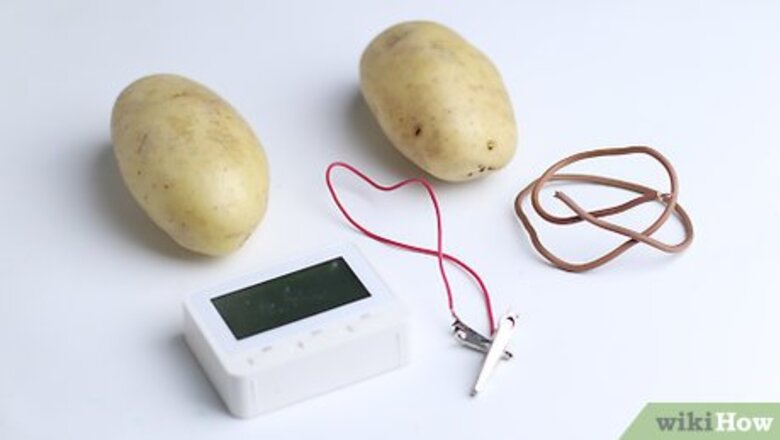
views
Making a 2-Potato Clock
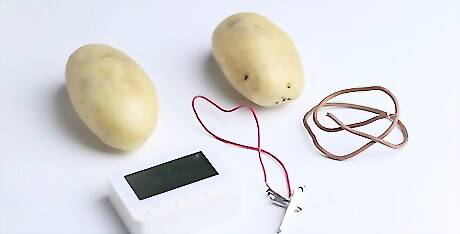
Gather the necessary materials. Before you can get started putting together your potato clock, you first must gather the items you’ll need. You can likely buy most of these items at your local hardware or hobby store, except the potatoes which will need to be purchased at a grocery store. 2 potatoes, any variety 2 pieces of copper wire 2 galvanized nails 3 alligator clip assemblies (each should be 2 clips connected by wire) A 1-2 volt digital clock
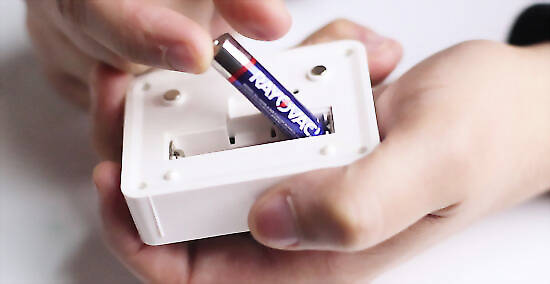
Remove the batteries from the digital clock. When completed, the potatoes will connect to the positive (+) and negative (-) ends of the battery terminals inside the clock, replacing the function of the batteries. You will want to keep the battery cover removed so you can easily access the terminals with your wires. If the clock does not have the positive (+) and negative (-) battery connectors labeled, mark them yourself using a permanent marker based on the way the batteries were connected. If they are labeled, the positive end will be marked with a “+” and the negative will be labeled with a “-“.
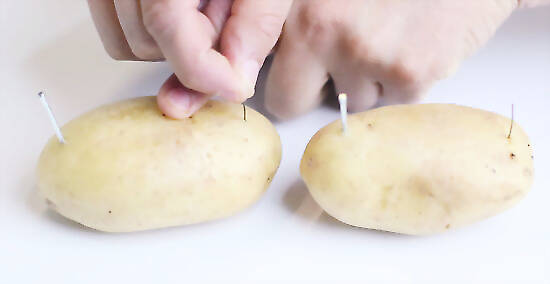
Insert 1 nail and 1 short piece of copper wire into each potato. Begin by labeling the potatoes as 1 and 2, this will help you to differentiate them as you move forward with the experiment. Then press 1 nail about 1 inch (2.5 cm) into each potato near the end. Once the nail is secured, press a piece of copper wire into the opposite end of the potatoes, as far from the nail as possible. Each potato should have 1 nail and 1 copper wire sticking out of opposite ends. Make sure the nail and wire aren’t touching inside the potato.
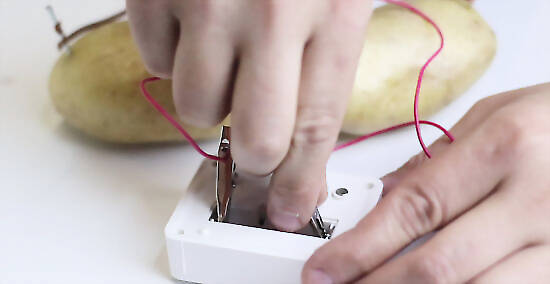
Use the alligator clips to connect the potatoes and clock. You will be connecting each of the potatoes and to the clock utilizing the 3 alligator clip units. In doing so, you will establish a circuit that includes the clock and each potato that will allow electrical current to pass through. Connect each of the following: Connect the copper wire in the first potato to the positive (+) terminal in the clock's battery compartment using the first alligator clip. Connect the nail on the second potato to the negative (-) terminal in the clock. Use the third alligator clip unit to connect the nail in the first potato to the copper wire in the second one.
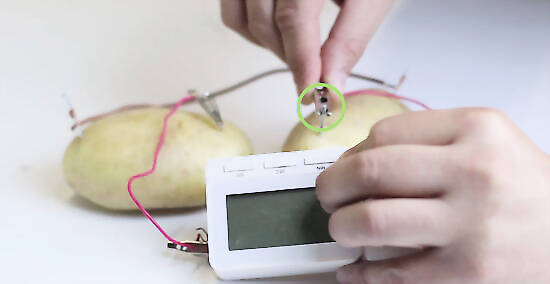
Check the connections and set the clock. As soon as you connect the third alligator clip unit to the 2 potatoes, the clock should turn on. If it fails to do so, check each of the connections to ensure they are tight and there is good metal-on-metal contact in each. This method will not last for very long, so after confirming that it works, you may want to disconnect it if you hope to enter the clock into a science fair or present it to your class.
Building a 3-Potato Clock

Begin by gathering your materials. As with any experiment, you must begin by gathering the materials you will need. You can purchase most of these materials at your local hardware or hobby store, or you may even have some of them at home already. Gather the following: 3 potatoes, any variety 3 copper strips or you can use pennies 3 galvanized nails 5 alligator clip units connected with wires (10 total clips) A 1-2 volt digital clock
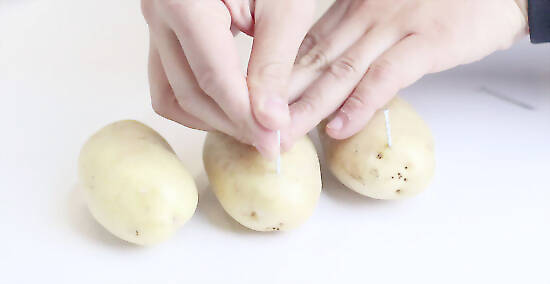
Place 1 nail in each potato. Just like making a 2-potato clock, each potato will need 1 galvanized nail inserted into it. Place the nail near the end of the potato and press it in about 1 inch (2.5 cm). Then, repeat the procedure for the other 2 potatoes. Make sure the nail doesn’t break through the other side of the potato. Ensure you don’t press the nail into the potato so that it will make it touch the penny or copper strip you will insert text.
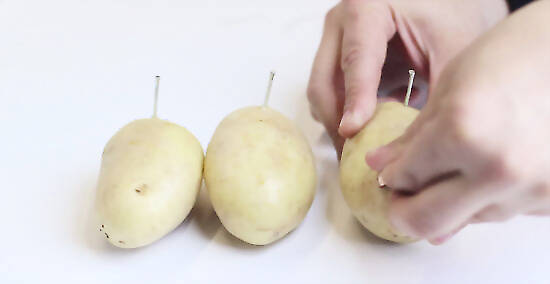
Insert a penny or copper strip into each potato. Press a penny or copper strip into each of the potatoes on the opposite end from the nail. If you are using a penny, make sure to press it into the potato so half of the penny is still visible above the surface of the potato skin so you can attach an alligator clip to it in the subsequent steps. If using a copper strip, make sure you don’t insert it so far into the potato that it comes into contact with the nail. Try to separate your copper from the nail as much as possible in the potato.
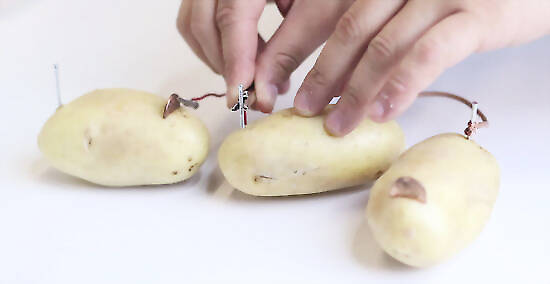
Connect the potatoes in a series. Once you have a galvanized nail and a piece of copper in the ends of each potato, you can connect them in a series to produce more electricity. Place the 3 potatoes in a row in front of you and use the alligator clip units and wires to connect them sequentially. Make sure the potatoes are lined up in the same way, with the nails all on one side and the copper on the other. Attach an alligator clip to the copper end of the first potato, then connect it to the nail on the second potato. Connect the copper end of the second potato to the nail of the third potato.
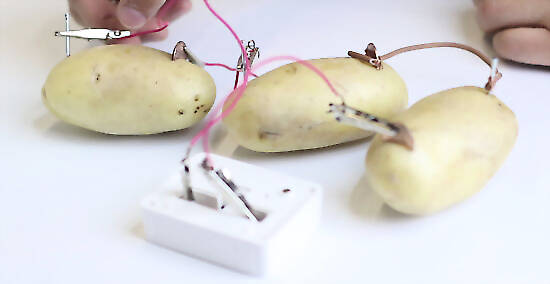
Connect the potatoes to the clock. The 2 outer potatoes should only have one wire connecting them to the middle potato. Now attach an alligator clip unit to the remaining nail on 1 potato, and another separate clip to the remaining piece of copper in the other potato. Attach the alligator clip unit from the nail to the negative (-) terminal inside the clock's battery compartment. Attach the alligator clip unit coming from the final piece of copper to the positive (+) battery terminal.

Check the connections and set the clock. Once both clips are attached to the positive (+) and negative (-) battery terminals, the clock should turn on. If it doesn’t, check each of the connections to ensure they are attached tightly and there is good metal on metal contact. Once connected securely, the clock will come on. You may want to disconnect it to avoid depleting the chemical energy in the potatoes if you need to show the experiment at a fair or in class.
Troubleshooting Your Potato Clock
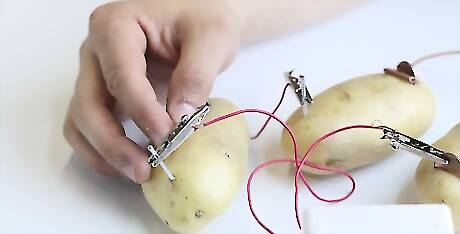
Check the wire connections. If your clock fails to work, there may be an issue with one of the connections between the potatoes or the clock. Make sure that each connection is tight and that there isn’t any material separating the metal of the alligator clip from the galvanized nail or the piece of copper. You also need to ensure the connections are made in the correct order: the nail on 1 potato should connect to the copper on the next. The negative (-) battery terminal should always be connected to a nail, while the positive (+) terminal should always go to the copper. Try replacing pennies with strips of copper to ensure a strong connection. Make sure each alligator clip is firmly attached where it belongs.
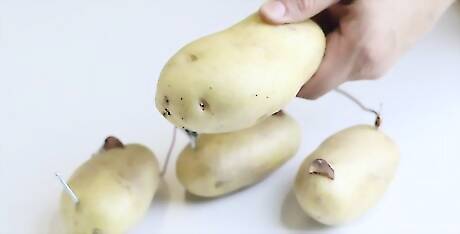
Add another potato. If everything is connected properly but the clock is still not working, it may be because your potatoes aren’t producing enough voltage to power the clock. You can use a multimeter or voltmeter to check the amount of voltage being produced by your potato batteries if you have them, or you can try adding another potato to your battery chain to increase the amount of power it produces. Connect an additional potato just as you connected the first ones: run an alligator clip unit from the copper of one potato to the galvanized nail on the next, then from the copper on that potato to the clock or the next potato. If another potato still does not make the clock work, there is either an issue with the connection or the clock.

Soak the potatoes in Gatorade. Soaking the potatoes overnight in Gatorade can increase their conductivity and help ensure your potato-powered clockworks. Gatorade contains electrolytes that can help conduct the electrical current through each potato, but you’ll need to soak the potatoes overnight to ensure the electrolytes reach the center of the potato. Gatorade also contains phosphoric acid, which adds to its conductive properties.

Swap the potatoes out for lemons or oranges. If you cannot make your potato-powered clock function, you may want to try swapping the potatoes out for another conductive fruit, like lemons or oranges. Place the nail and copper into the fruit just as you did the potato. Rolling the fruit on the table first can help break down the fruit's interior, allowing fluid to travel more easily, and as a result, the electrical current.

Ensure you have the right materials. Using the incorrect materials can make it far more difficult or even impossible to correctly assemble your potato clock. Look over your materials and the packaging they came in so you can make sure you have exactly what you think you have. Make sure the package you purchased the nails in says they are galvanized. While most nails are, this experiment will not work if they are not. Ensure the clock you purchased runs on 1-2 volts and takes a traditional “button-type” battery. You can see how many volts it requires on the product information on the package.















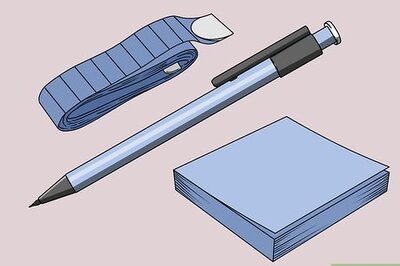




Comments
0 comment